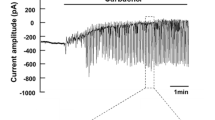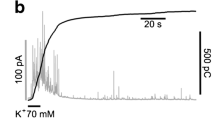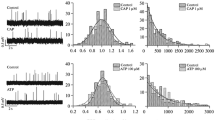Abstract
The ionic dependence of the acetylcholine equilibrium potential (EACh) of acinar cells in which acetylcholine (ACh) induced hyperpolarization under control conditions was investigated using intracellular micro-electrode recording in superfused segments of mouse submaxillary gland. For measurements of EACh two micro-electrodes were inserted into neighbouring communicating cells, direct current was passed through one of these electrodes and EACh was determined by plotting the relation between the size of the ACh potential and the resting potential. ACh was applied by micro-iontophoresis.
A complex potential change was induced by ACh when the membrane potential was set at high levels (−50∼ −80 mV). The appearance of complex responses dependend on the external [Na]. A severe reduction in external Na concentration abolished the appearance of complex responses, whereas alterations of external K concentration had no such effect. The results indicate that a depolarizing component separate from the hyperpolarizing component exists even in acinic in which ACh only evokes hyperpolarization under control conditions. Intracellular injection of TEA ions converted the ACh evoked potential change from hyperpolarization to depolarization in acini superfused with solutions containing Na in concentrations between 50 and 135 mM. However, the conversion was never obtained using solutions with low Na concentration (12.5 mM).
The mean EACh was −60 mV under normal conditions. EACh was made more negative (5 mV) by a reduction in external Na concentration from 135 to 12.5 mmol·l−1. EACh was influenced by alterations of external K concentration, particularly when combined with reduction in external Na concentration. Alteration of K concentration from 2 to 20 mmol·l−1 shifted EACh to more positive values by about 40 mV. EACh in acini treated with TEA was about −28 mV in control solution (Na: 135 mmol·l−1) and −35 mV in a low Na concentration (50 mmol·l−1).
Assuming that the response in submaxillary gland acinar cells to ACh under control condition is composed of two different kinds of potential changes (depolarization and hyperpolarization), the ionic basis of each of the potential changes and a possible explanation for the mechanism of ACh are discussed.
Similar content being viewed by others
References
Iwatsuki N, Petersen OH (1978) Intracellular Ca2+ injection causes membrane hyperpolarization and conductance increase in lacrimal acinar cells. Pflügers Arch 377:185–187
Katz B, Miledi R (1967) A study of synaptic transmission in the absence of nerve impulses. J Physiol (Lond) 192:407–436
Kehoe J (1969) Single presynaptic neurone mediates a two component postsynaptic inhibition. Nature 221:866–868
Kleinhaus AL, Prichard JW (1974) Calcium dependent action potential produced in leech Retzius cells by tetraethylammonium chloride. J Physiol (Lond) 246:351–361
Koelz HR, Kondo S, Blum AL, Schulz I (1977) Calcium ion uptake induced by cholinergic and α-adrenergic stimulation in isolated cells of rat salivary glands. Pflügers Arch 370:37–44
Kusano K, Livengood R, Werman R (1967) Correlation of transmitter release with membrane properties of the presynaptic fiber of squid giant synapse. J. Gen Physiol 50:2579–2601
Petersen OH (1970) The dependence of the transmembrane salivary secretory potential on the external potassium and sodium concentration. J Physiol (Lond) 210:205–215
Petersen OH (1976) Electrophysiology of mammalian gland cells. Physiol Rev 56:535–577
Putney JW Jr (1976) Stimulation of45Ca influx in parotid gland by carbachol. J Pharmacol Exp Ther 199:526–537
Roberts ML, Petersen OH (1978) Membrane potential and resistance changes induced in salivary gland acinar cells by microiontophoretic application of acetylcholine and adrenergic agonists. J Membr Biol 39:297–312
Roberts ML, Iwatsuki N, Petersen OH (1978) Parotid acinar cells: ionic dependence of acetylcholine0evoked membrane potential change. Pflügers Arch 376:159–167
Schneyer LH, Schneyer CA (1960) Electrolyte and inulin spaces of rat salivary glands and pancreas. Am J Physiol 199:649–652
Wakui M, Nishiyama A (1980) ACh-evoked complex membrane potential changes in mouse submaxillary gland acini: a study employing channel blockers and atropine. Pflügers Arch 386:251–259
Author information
Authors and Affiliations
Rights and permissions
About this article
Cite this article
Wakui, M., Nishiyama, A. Ionic dependence of acetylcholine equilibrium potential of acinar cells in mouse submaxillary gland. Pflugers Arch. 386, 261–267 (1980). https://doi.org/10.1007/BF00587477
Received:
Accepted:
Issue Date:
DOI: https://doi.org/10.1007/BF00587477




